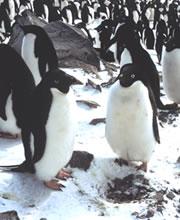 Old eggs show Adélie penguins switched from fish to shrimp 200 years ago.S. Emslie
Old eggs show Adélie penguins switched from fish to shrimp 200 years ago.S. EmslieAncient eggshell fragments show that Adélie penguins living in Antarctica switched from eating fish to krill around the time that humans began hunting seals and whales. The finding suggests that when humans removed krill-eating predators the penguins exploited the resulting shrimp surplus.
Steven Emslie of the University of North Carolina in Wilmington, and William Patterson of the University of Saskatchewan in Saskatoon, analysed more than 220 fossil eggshell pieces ranging from 100 to 38,000 years old, and compared them with samples from modern nests.
By comparing the proportion of certain forms of carbon and nitrogen in the shells with the proportions found in fish and krill, the researchers could tell what the birds had been eating.
Emslie expected to find changes in diet matching climate change. Instead, the penguin menu remained biased towards fish until about 200 years ago, when the birds switched to krill.
Recent global warming and the rise in krill fisheries has reduced krill stocks and could be contributing to the decline in Adélie penguin populations on the Antarctic Peninsula, says Emslie. The study is published in the Proceedings of the National Academy of Sciences1.
Dietary switch
“This implies a huge dietary response.”
Keith Hobson, Canadian Wildlife Service, Saskatchewan.
From 1793 to 1807, an estimated 3.2 million seals were taken from the Southern Ocean. The resulting crash in the seal population — including the Antarctic fur seal Arctocephalus gazella, which fed primarily on krill — caused the industry to collapse.
Whaling took off in the 1800s and continued until the mid-twentieth century, eventually depleting baleen whale populations by more than 90%. It's estimated that the combined harvest of seals and whales resulted in more than 150 million tonnes of extra krill each year.
Krill is an attractive food for penguins because it is high in protein and tends to travel in swarms. "The birds can capture lots of high-energy prey in a short time," says Emslie.
"This implies a huge ecological dietary response by the penguins in relation to some change in their environment," says Keith Hobson of the Canadian Wildlife Service in Saskatchewan. But the reasons behind this switch are less obvious, he says.
"Abundance of a secondary food item does not necessarily explain this unless it was accompanied by a reduction in fish," says Hobson. "Why does it matter that krill became more abundant to a predator that previously happily made eggs from fish?"
A further boost
ADVERTISEMENT
The switch might be explained by an increase in fishing, says David Ainley of the California ecological consulting firm H. T. Harvey & Associates. "Not only were whales and seals removed," he says, "there was a massive removal of fish from the Scotia Sea and western Antarctic Peninsula region at the same time." Many of these fish ate krill, so their removal would have further boosted krill supplies.
Their dietary flexibility demonstrates the penguins' ability to adjust to large ecological changes, but that doesn't mean they'll survive the changes to come, says Hobson. "I remain a pessimist when it comes to how they may now cope with the onslaught of climate change," he says.
Visit our madepenguinsswitcht.html">newsblog to read and post comments about this story.
